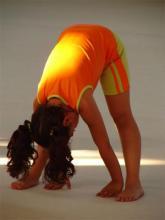
Flexibility refers to the body’s ability to effectively bend and move without injury. Improving flexibility allows the body to increase the range of motion at a particular joint as well as improving bone, ligament, and joint stability. Similar to other physical motor skills, flexibility is an ongoing process rather than a static point of achievement, and the best way to keep the body flexible is to use it. Poor flexibility hinders performance in every other physical motor skill.1
Children are naturally involved in numerous activities that develop their flexibility. They are constantly bending, twisting, turning, and stretching as they navigate playground equipment or play a ball game. As children improve their flexibility, they exhibit better motor performance, fluidity of movement, and increased range of motion. They play more efficiently and have a reduced risk of injury when they are more flexible.2 Some sports activities that require good flexibility are gymnastics, swimming, diving, figure skating, wrestling, tennis, and martial arts.3 Children who demonstrate good flexibility may also enjoy dancing, especially ballet.4
Children are born with a specific predetermined range of motion and degree of flexibility of their joints, muscles, and tissues that are looser or tighter than others. There are many other factors that affect flexibility that vary from person to person. Since flexibility is joint specific, a child may be flexible in one joint and not in another. Torn or stretched ligaments or tendons can actually make a joint unstable with too much flexibility. If a child is overweight, his flexibility will be limited. Inactivity for a long period of time can also decrease flexibility and lead to tightness over time.5
Children’s natural flexibility varies by age. The maximum natural flexibility of the spine is reached by the age of 8 or 9.6 Children start to lose flexibility at the age of 10, because their bones are growing faster than their muscles. However, their flexibility starts to improve again around the age of 13 for girls and 14 for boys. It is important then for children between the ages of 10 and 13 to stay flexible through physical activity and sports when they have less natural flexibility.7
Children who have poor muscle flexibility experience more soreness, tenderness, and pain after exercise, which could result in injury. Stretching exercises during warm-up before a sports practice or game and during cool-down after the activity can improve their flexibility.8 Stretching also increases blood and nutrients to the tissues, improves performance, and aids coordination.9
- 1. Rodi, Cyndi. “CrossFit Kids 101.” CrossFit Kids.com. < http://www.crossfitkids.com/index.php/crossfit101/ > 15 Nov. 2010.
- 2. Gallahue, David L. and Frances Cleland Donnelly. Developmental Physical Education for All Children. 4th ed. Champaign, IL: Human Kinetics. 2003. pp. 87-88.
- 3. Stricker, Paul R. “Body Composition and Flexibility.” HealthyChildren.org. < http://www.healthychildren.org/English/healthy-living/fitness/pages/Body-Composition-and-Flexibility.aspx > 15 Nov. 2010.
- 4. “Why Exercise Is Cool.” KidsHealth from Nemours. < http://kidshealth.org/kid/stay_healthy/fit/work_it_out.html# > 15 Nov. 2010.
- 5. Bentz, Bryan S. and Douglas R. Curnes. “Flexibility: An Important Component in Your Fitness Regimen.” Buzzle.com. < http://www.buzzle.com/editorials/7-12-2006-102151.asp > 15 Nov. 2010.
- 6. Grasson, Brian J. “Flexibility – Are we hurting kids?” Brianmac Sports Coach. < http://www.brianmac.co.uk/articles/scni17a3.htm > 15 Nov. 2010.
- 7. “Flexibility In Soccer Helps.” MomsTeam.com. < http://www.momsteam.com/sports/soccer/flexibility-helps-to-reduce-sports-injuries > 15 Nov. 2010.
- 8. Ibid.
- 9. Waehner, Page. “Exercise for Beginners – Flexibility.” About.com:Exercise. < http://exercise.about.com/cs/exbeginners/a/begflexibility.htm > 15 Nov. 2010.

